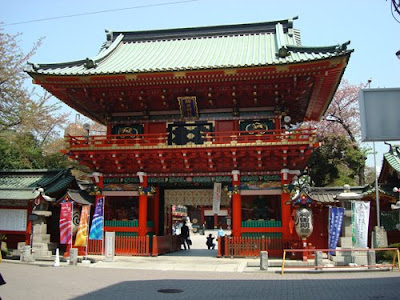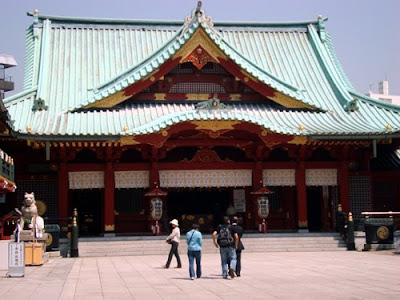Kanda Myojin Tokyo
17:31
神田明神
Kanda Myojin Shrine in the Kanda district of Tokyo is not far from Ochanomizu Station. Formally known as Kanda Jinja, the complex enshrines the deities for 108 Tokyo neighborhoods including Akihabara, Kanda, Nihombashi and Tsukiji Fish Market.

People come here to pray for the usual success in business, good health and happy marriage. There are large statues of the Shinto favorites Daikoku, Ebisu, and Taira-no-Masakado.
The shrine's origins go back to 730, though Kanda Myojin on its present site dates from 1603, when Tokugawa Ieyasu expanded Edo Castle and moved the shrine to Kanda.

The 17th century wooden buildings were destroyed in the Great Kanto Earthquake of 1923 and were then rebuilt in concrete - the shrine survived the fire-bombing of Tokyo in World War II, as a result. The wooden Zuishin Gate was rebuilt after the war using cypress (hinoki) and restorations have continued until recently on other buildings in the shrine complex.
Kanda Myojin is the home shrine of the Kanda Matsuri, which is held every two years in May with horen (imperial palanquins) and mikoshi (portable shrines) paraded through the neighborhood. A smaller parade takes place in the intervening years.

Access
Kanda Myojin
Chiyoda-ku, Sotokanda 2-16-2
101-0021
Tel: 03 3254 0753
Take a Chuo & Sobu Line train to Ochanomizu Station (Higiri Bridge Exit) or a
Yamanote or Keihin-Tohoku Line train to Akihabara Station (Denkigai Exit) and then a short 5-7 minute walk. Alternatively, ride a subway to either Ochanomizu or Akihabara statons. A Toei bus also passes close to the shrine.
Yahoo Japan Auction Service
Rough Guide To Japan
Tags
Japanese shrines Tokyo Japanese festivals
Kanda Myojin Shrine in the Kanda district of Tokyo is not far from Ochanomizu Station. Formally known as Kanda Jinja, the complex enshrines the deities for 108 Tokyo neighborhoods including Akihabara, Kanda, Nihombashi and Tsukiji Fish Market.

People come here to pray for the usual success in business, good health and happy marriage. There are large statues of the Shinto favorites Daikoku, Ebisu, and Taira-no-Masakado.
The shrine's origins go back to 730, though Kanda Myojin on its present site dates from 1603, when Tokugawa Ieyasu expanded Edo Castle and moved the shrine to Kanda.

The 17th century wooden buildings were destroyed in the Great Kanto Earthquake of 1923 and were then rebuilt in concrete - the shrine survived the fire-bombing of Tokyo in World War II, as a result. The wooden Zuishin Gate was rebuilt after the war using cypress (hinoki) and restorations have continued until recently on other buildings in the shrine complex.
Kanda Myojin is the home shrine of the Kanda Matsuri, which is held every two years in May with horen (imperial palanquins) and mikoshi (portable shrines) paraded through the neighborhood. A smaller parade takes place in the intervening years.

Access
Kanda Myojin
Chiyoda-ku, Sotokanda 2-16-2
101-0021
Tel: 03 3254 0753
Take a Chuo & Sobu Line train to Ochanomizu Station (Higiri Bridge Exit) or a
Yamanote or Keihin-Tohoku Line train to Akihabara Station (Denkigai Exit) and then a short 5-7 minute walk. Alternatively, ride a subway to either Ochanomizu or Akihabara statons. A Toei bus also passes close to the shrine.
Yahoo Japan Auction Service
Rough Guide To Japan
Tags
Japanese shrines Tokyo Japanese festivals
コメントを投稿